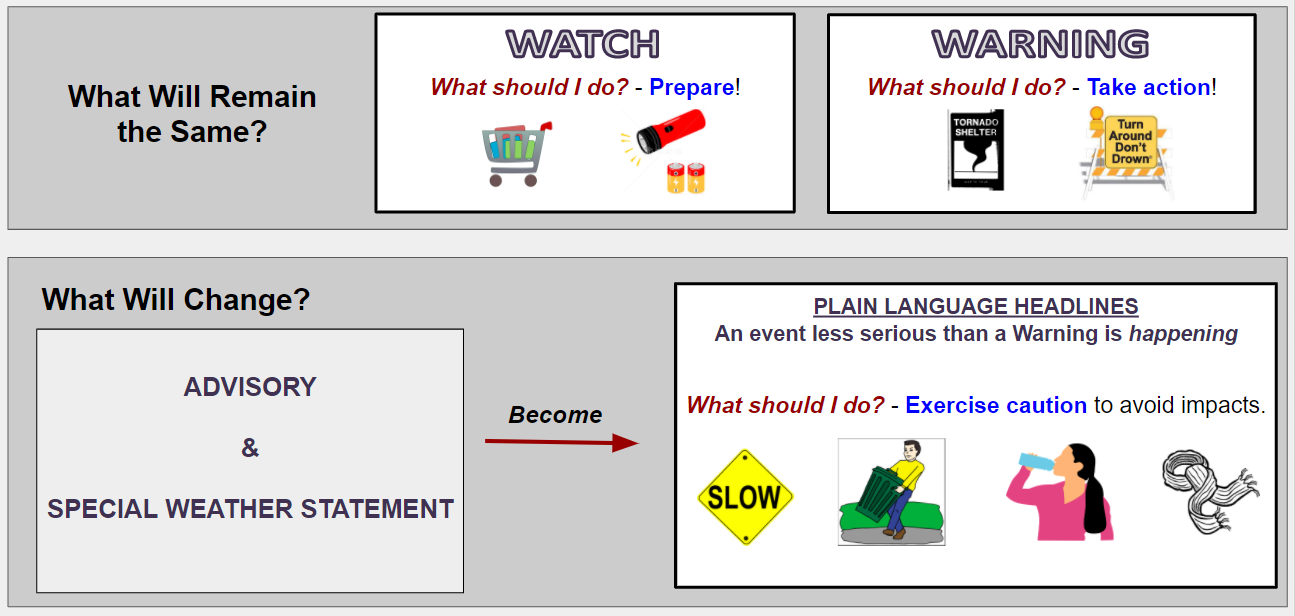Warnings, Watches, and Advisories: What You Need to Know
- By Amber Liggett, MSEM
- Feb 14, 2023
Amber Liggett is a communications analyst for Groundswell Consulting Group working as a Federal contractor at The National Oceanic and Atmospheric Administration (NOAA) Climate Program Office.
Whenever weather happens, you will find a Watch, Warning, or Advisory (WWA) issued by the National Weather Service (NWS). These WWA alerts provide a heads up for when, what kind, and where a weather hazard will impact a region. While these alerts are specific to hazards like tornadoes, thunderstorms, flooding, etc., there are universal definitions for all of them at large.
The NWS Glossary defines a Watch, Warning, and Advisory respectively.
Watch
A watch is used when the risk of a hazardous weather or hydrologic event has increased significantly, but its occurrence, location, and/or timing is still uncertain. It is intended to provide enough lead time so that those who need to set their plans in motion can do so.
Warning
A warning is issued when a hazardous weather or hydrologic event is occurring, is imminent, or has a very high probability of occurring. A warning is used for conditions posing a threat to life or property.
Advisory
Highlights special weather conditions that are less serious than a warning. They are for events that may cause significant inconvenience, and if caution is not exercised, it could lead to situations that may threaten life and/or property.
As a note, there are other NWS alerts outside of these three, including a Special Weather Statement. Special Weather Statements provide information on events that are less serious, or of shorter duration, than an Advisory. We will mainly focus on WWA alerts in this article.
Hazard Simplification (Haz Simp) Project
Since 2014, NWS has been formally assessing the strengths and weaknesses of the WWA system through the Hazard Simplification Project. After learning that people are oftentimes confused by the terms, in 2021, the NWS made the decision to remove the Advisory headline from its WWA system in favor of plain language headlines. According to the NWS, “Plain language headlines will be short messages that clearly and simply describe the hazard, but still signal the audience to take note. To provide time for public outreach, partner adjustments, and NWS policy and software development, this change will not occur before 2024.”

The above graphic from the NWS Haz Simp Project describes the future changes. You’ll notice Watches and Warnings will remain the same. The 24 Advisories and Special Weather Statements currently being issued will be removed and transitioned to plain language headlines for weather or water events that do not rise to the level of a Warning. You can read more about this project in the frequently asked questions page here.
By visiting the NWS website homepage, you can see the full WWA map of the U.S., plus links to U.S. territories showing what alerts are currently active 24/7. Below the map, you can see the full list of active alerts. Every alert is hyperlinked for you to click on them and see the detailed description of the alert message. The criteria for what classifies a hazard as a Watch, Warning, or Advisory varies depending on the county warning area, so it is imperative that you regularly check your local forecast carefully to understand which alert might be issued for your region.
